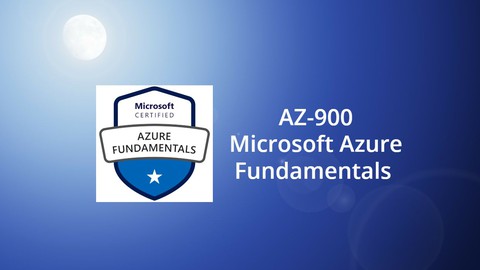Descrição
Descrição:
Simulado Prova para a Certificação Exame AZ-900: Microsoft Azure Fundamentals
Exame AZ-900: Microsoft Azure Fundamentals
O conteúdo deste exame foi atualizado em 23 de Maio de 2021.
ESTA PROVA EXISTE SOMENTE EM INGLÊS – O SIMULADO ESTA TODO EM INGLÊS
Os candidatos a este exame devem ter conhecimentos básicos nos serviços em nuvem e como os serviços são provisionados com o Microsoft Azure. O exame é destinado a candidatos que estão apenas começando a trabalhar com soluções e serviços baseados em nuvem ou que não estão familiarizados com o Azure.
O exame Azure Fundamentals é uma oportunidade de provar conhecimento de conceitos de nuvem, serviços, cargas de trabalho, segurança e privacidade no Azure, bem como preços e suporte do Azure. Os candidatos devem estar familiarizados com os conceitos gerais de tecnologia, incluindo conceitos de rede, armazenamento, computação, suporte a aplicativos e desenvolvimento de aplicativos.
O curso Azure Fundamentals pode ser usado para preparar o candidato para outras certificações baseadas em funções ou especialidades do Azure, mas não é um pré-requisito para nenhuma delas.
Você pode se qualificar para o crédito ACE de faculdade se passar neste exame de certificação. Consulte ACE crédito de faculdade para exames de certificação para obter detalhes.
Describe Cloud Concepts (20-25%)
Identify the benefits and considerations of using cloud services
identify the benefits of cloud computing, such as High Availability, Scalability, Elasticity, Agility, and Disaster Recovery
identify the differences between Capital Expenditure (CapEx) and Operational Expenditure (OpEx)
describe the consumption-based model Describe the differences between categories of cloud services
describe the shared responsibility model
describe Infrastructure-as-a-Service (IaaS),
describe Platform-as-a-Service (PaaS)
describe serverless computing
describe Software-as-a-Service (SaaS)
identify a service type based on a use case Describe the differences between types of cloud computing
define cloud computing describe Public cloud
describe Private cloud describe Hybrid cloud
compare and contrast the three types of cloud computing
Describe Core Azure Services (15-20%)
Describe the core Azure architectural components
describe the benefits and usage of Regions and Region Pairs
describe the benefits and usage of Availability Zones
describe the benefits and usage of Resource Groups
describe the benefits and usage of Subscriptions
describe the benefits and usage of Management Groups
describe the benefits and usage of Azure Resource Manager
explain Azure resources Describe core resources available in Azure
describe the benefits and usage of Virtual Machines, Azure App Services, Azure Container Instances (ACI), Azure Kubernetes Service (AKS), and Windows Virtual Desktop
describe the benefits and usage of Virtual Networks, VPN Gateway, Virtual Network peering, and ExpressRoute
describe the benefits and usage of Container (Blob) Storage, Disk Storage, File Storage, and storage tiers
describe the benefits and usage of Cosmos DB, Azure SQL Database, Azure Database for MySQL, Azure Database for PostgreSQL, and SQL Managed Instance
describe the benefits and usage of Azure Marketplace
Describe core solutions and management tools on Azure (10-15%)
Describe core solutions available in Azure
describe the benefits and usage of Internet of Things (IoT) Hub, IoT Central, and Azure Sphere
describe the benefits and usage of Azure Synapse Analytics, HDInsight, and Azure Databricks
describe the benefits and usage of Azure Machine Learning, Cognitive Services and Azure Bot Service
describe the benefits and usage of serverless computing solutions that include Azure Functions and Logic Apps
describe the benefits and usage of Azure DevOps, GitHub, GitHub Actions, and Azure DevTest Labs Describe Azure management tools
describe the functionality and usage of the Azure Portal, Azure PowerShell, Azure CLI, Cloud Shell, and Azure Mobile App
describe the functionality and usage of Azure Advisor describe the functionality and usage of Azure Resource Manager (ARM) templates
describe the functionality and usage of Azure Monitor
describe the functionality and usage of Azure Service Health
Describe general security and network security features (10-15%)
Describe Azure security features
describe basic features of Azure Security Center, including policy compliance, security alerts, secure score, and resource hygiene
describe the functionality and usage of Key Vault
describe the functionality and usage of Azure Sentinel
describe the functionality and usage of Azure Dedicated Hosts Describe Azure network security
describe the concept of defense in depth
describe the functionality and usage of Network Security Groups (NSG)
describe the functionality and usage of Azure Firewall
describe the functionality and usage of Azure DDoS protection
Describe identity, governance, privacy, and compliance features (20- 25%)
Describe core Azure identity services
explain the difference between authentication and authorization
define Azure Active Directory
describe the functionality and usage of Azure Active Directory
describe the functionality and usage of Conditional Access, Multi-Factor Authentication (MFA), and Single Sign-On (SSO) Describe Azure governance features
describe the functionality and usage of Role-Based Access Control (RBAC)
describe the functionality and usage of resource describe the functionality and usage of tags describe the functionality and usage of Azure Policy
describe the functionality and usage of Azure Blueprints describe the Cloud Adoption Framework for Azure Describe privacy and compliance resources
describe the Microsoft core tenets of Security, Privacy, and Compliance describe the purpose of the Microsoft Privacy Statement, Product Terms site, and Data Protection Addendum (DPA)
describe the purpose of the Trust Center
describe the purpose of the Azure compliance documentation
describe the purpose of Azure Sovereign Regions (Azure Government cloud services and Azure China cloud services)
Describe Azure cost management and Service Level Agreements (10- 15%)
Describe methods for planning and managing costs
identify factors that can affect costs (resource types, services, locations, ingress and egress traffic)
identify factors that can reduce costs (reserved instances, reserved capacity, hybrid use benefit, spot pricing)
describe the functionality and usage of the Pricing calculator and the Total Cost of Ownership (TCO) calculator
describe the functionality and usage of Azure Cost Management Describe Azure Service Level Agreements (SLAs) and service lifecycles
describe the purpose of an Azure Service Level Agreement (SLA)
identify actions that can impact an SLA (i.e. Availability Zones)
describe the service lifecycle in Azure (Public Preview and General Availability)






Avaliações
Ainda não existem avaliações.